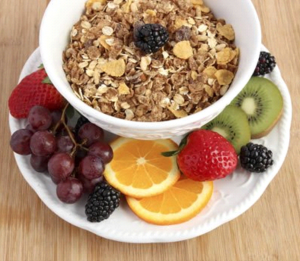Part 3 – How Healthy Food Affects Children
Improved Academic Performance
Improving your child’s healthy eating habits may help your kid academically as well. A study published in the European Journal of Nutrition found evidence that children who eat healthy are more likely to develop higher reading comprehension levels and earn better test scores. The students in the study who made poorer dietary choices exhibited slower reading progress over the two years they were followed, regardless of other factors such as socio-economic status and level of physical activity.
Establishment of Healthy Habits
Let us teach you how to learn necessary lifestyle changes, but the true benefit comes from the establishment of healthy habits. By learning how to make nutritious snacks, stay active, and make other healthy strategies a natural part of everyday life. You have to incorporate some of the healthy habits with your family at home to help your child continue these changes for a lifetime. With ACE wellness adults learn right along with their children, to step away from the screen and discover how much fun a healthy, active lifestyle can be. They may even discover that they enjoy yoga or swimming more than their favorite computer game.
Expand Taste Palate
If you are the parent of a picky eater, you know how exhausting it can be to try to introduce him or her to new foods day after day. So why not have someone else give it a shot? Sometimes kids are more willing to take advice from strangers than their own parents.
Development of Responsibility
Though parents play an important role in teaching their children healthy habits, at some point kids need to learn to take responsibility for their own health. ACE wellness gives them this opportunity. By learning about and establishing a healthy lifestyle through their own daily decisions instead of being forced to do so by a parent, kids may begin to take more ownership for their nutritional choices in the future.
Your Great-Great Grandmother Knew Better
Your great-great grandmother would know potatoes. She’d be wary (and we should be, too) of potato chips, not to mention French fries with chili cheese sauce. She’d recognize fresh strawberries and oats, not strawberry flavoured breakfast cereal. She’d know whole-grain bread, not bagel snack chips.
If she were from Italy, she’d know fresh tomatoes, garlic, and herbs, not canned tomato sauce. What, more specifically, are real, or good, carbs? They’re fresh fruits; fresh vegetables; whole grains like oats, barley, whole-grain couscous, brown rice, quinoa, millet, and sprouted whole-grain bread; starchy vegetables like potatoes, corn, and yams; and legumes like black beans, peas, and pinto beans. Does the above look like our Western diet? Not even close! The main features of the Western diet are lots of meat; full-fat dairy foods like butter and cheese; and processed, super-calorie-dense carbs full of fat, salt, and/or sugar, such as donuts, corn chips, white-flour bread, macaroni and cheese, pretzels and cereal bars. In short, the Western diet has lots of everything except fruits, vegetables, legumes, and whole grains.
Good Carbs vs. Bad Carbs
Why are good carbs like fruits, vegetables, legumes, and whole grains (especially cooked whole grains) so good for us? Let us count just some of the many ways.
Good carbs are:
• Low to moderate calorie intake, which means we can eat filling amounts, and satisfy our hunger, but not worry about going overboard on calories.
• High in an enormous variety of nutrients.
• Completely avoid refined sugars and refined grains. In America, refined sugars like corn syrup now make up more than 20% of the calories we eat each day.
That’s a big problem because our human bodies evolved over centuries and centuries to metabolize unrefined carbohydrates. We’re equipped to handle corn. We’re clueless about high fructose corn syrup. Daily tsunamis of sugar in our bloodstream are directly linked to our current epidemics of obesity and type 2 diabetes.
• High in naturally occurring fiber, which helps lower not only blood sugar and insulin levels but also LDL bad cholesterol. Fiber-rich foods also help you fill up
on fewer calories so that you can lose weight more easily. A high-fiber diet also helps prevent constipation, hemorrhoids, and certain cancers. Americans average just 12 to 15 grams of fiber a day. Nutrition experts say we ought to be getting at least 35 to 50 fiber grams daily.
• Low in sodium.
• Low in saturated fat.
• Very low (often zero) cholesterol, and no trans fats.
Fake, processed (bad) carbs, the carbs consumed by most North Americans, are:
• High in calorie density. (Just a few bites of a corn dog or energy bar, and you’ve taken in a bunch of calories.)
• High in refined sugars (whether white sugar, corn syrup, or so-called “natural” sugars like honey and added fruit juices).
• High in refined grains like white flour.
• Low in many nutrients.
• Low in fiber.
• High (often very high) in sodium.
• Sometimes high in saturated fat.
• Sometimes high in cholesterol and trans fats.
From the bullets above, it’s easy to see how a diet rich in good carbs can lead to a lean body and good health. And how a diet of processed carbs like white flour and sat-fat-rich foods like 16-ounce steaks and cheeseburgers has busted not only our health but also our health-care system. We’re shelling out an unsustainable billions of dollars annually in diet-related health-care costs, often spent on horrifically priced and sometimes questionably effective procedures like angioplasties and heart bypass operations. The money we’d save by returning to our dietary roots – fresh fruits, fresh veggies, and whole grains – is mind-boggling. Eat foods naturally high in fiber, not foods labeled “high in fiber” because fiber was added to them. There’s a lot of this going on lately, especially in the bread and cereal aisles. Products are full of heavily processed, refined grains (yes, bad carbs) but boast that they’re fiber-rich because wheat brain or another isolated bran has been added to them.
Choose good carbs that are naturally rich in fiber over foods with added fiber. So stick to the real thing. Our bodies have a longstanding relationship with whole grains, not stripped grains that have been injected with a little wheat bran. To ensure you’re getting the real thing in the supermarket, buy bread, pastas, and other grain products that show as their first ingredient whole grain, such as whole-wheat flour or sprouted whole-grain kernels. And see what else is in that ingredient list. Whole grains won’t do you much good if they’re mixed with molasses, honey, sorbitol, and other simple sugars, or if the product
has a lot of sodium, which many types of bread do.
COVID – 19: Enjoy Home Life
One of the best ways to achieve optimal health and escape our obesity-causing culture of fast foods and bad carbs is to eat at home more often. Right now we as a nation need to stay home more than ever to protect our communities. Put a huge platter of fresh fruit and veggies on the kitchen table. Eat everything in it every day. Replenish it everyday. Order groceries, or venture out as little as possible taking all precautions and stock up for two weeks. In Canada you can get whole, healthful foods like fresh fruit, fresh vegetables, potatoes, brown rice and other whole grains that you cook, and beans, as well as nonfat dairy foods, fish, chicken, and even lately, very lean red meat like bison. Just start out in the produce section. Fill your cart halfway with fruit and veggies. Now,
you’re on the ACE wellness track! When you return home, retreat to the kitchen away from the stresses of the day. Lose yourself in the joy of your own cooking. Then sit down to a meal that’s tremendously good, and tremendously good for you, carbs and all.
We hope you enjoyed our tips and tricks for keeping your family and loved ones healthy and happy.
Renata, Sophie








